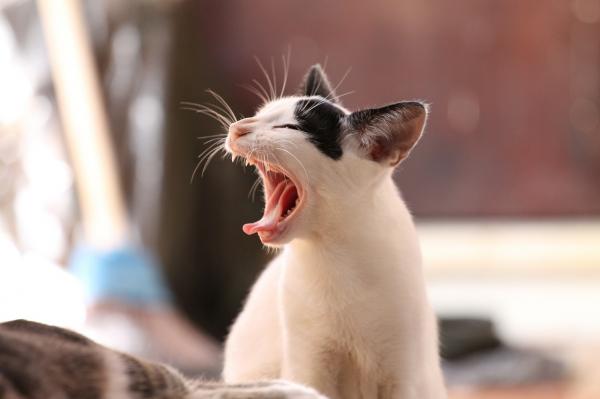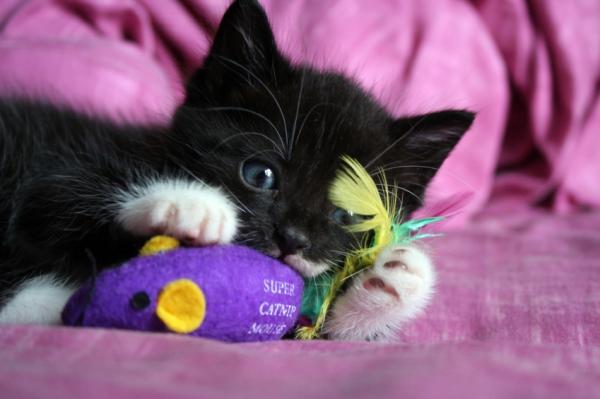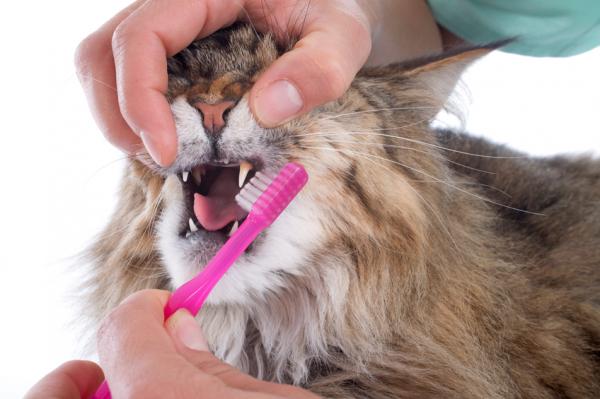At what age do baby teeth change cats?

Surely you did not know, but cats also they change their teeth as they grow. If you have a feline puppy at home and at some point you discover one of its small but sharp teeth, do not be frightened! That is completely normal.
As happens with humans, the replacement of the denture occurs at a specific time in life and is accompanied by certain discomfort that you must know to know how to deal with and facilitate the process to your pussy. If you want to know at what age do baby teeth change?, keep reading this article.
Characteristics of cats’ milk teeth
Cats are born without teeth, the first weeks of life can only be fed with the milk of the mother. The so-called milk teeth appear after the third week of life, approximately from day 16 onwards.
First appear the incisors, then the canines and finally the premolars, until reaching a total of 26 dental pieces upon arriving at the eighth week. Although small, these first teeth are quite sharp, so that little by little the cat will stop nursing the puppies for the damage they do, so it will be time to move to a little more solid, although soft foods.

When do cats move their teeth?
These milk teeth are not permanent, so from the 3 or 4 months of age the kitten will begin to move them by the so-called permanent teeth. The process of change of teeth is much slower than the appearance of the first, so it extends until the month 6 or 7, when the new denture must have already appeared completely. In this way, it is not surprising that you notice that your cat has dropped a tooth during this period of time.
First appear the incisors, then the canines, then the premolars and finally a new set of pieces, the molars, until completing 30 teeth. As we said, during the moult you are likely to find some of the teeth at home, but if your kitten is between the indicated ages you have nothing to worry about.
The process is that the permanent teeth are “hidden” in the gums, so they begin to pressure the milk to detach and take their place. It is a natural procedure, but occasionally a complication may appearAs an tooth retained.
It is said that a tooth is retained when the piece of milk fails to detach despite the pressure exerted by the permanent tooth for this to occur. When this is the case, all the denture suffers problems, because the pieces are displaced from the place that corresponds to them due to the compression force that is exerted on them. It requires a visit to the veterinarian to determine which is the best option for all the teeth to come out correctly.
Are there any discomforts during the change of teeth?
The replacement of milk teeth by permanent teeth causes different discomforts in the pussycat, very similar to those experienced by children when the first teeth come out. It is possible that your kitten:
- Feel pain
- It irritates the gums
- Babee in excess
- Have bad breath
- Show irritable
- Hit your mouth with your legs
Due to all these discomforts, the kitten refuses to eat mainly because of the pain he feels, but will look for nibbling everything you find at your fingertips, because this gesture relieves a little the irritation in the gums.
To avoid that with these bites destroy the furniture of the home and everything else that comes to mind, we recommend purchase cat toys made of rubber or a soft plastic so I can chew them all I want. Remove from the reach of the cat any object of value, or that could cause harm if you bite, offer the toy and prémialo with caresses when you take it to interpret that this is the object to bite. Check the following article and discover the most recommended toys: “Ideal toys for small cats”.
In addition, moisten the food that you give him, because the solids will be difficult to chew; You can also replace your dry food with canned goods temporarily.

Characteristics of permanent teeth of cats
As we said, cats change their milk teeth permanently permanently around the 6 or 7 months. These pieces are what the cat will have the rest of his life, so many experts recommend different methods to keep them in good condition and avoid diseases, such as brushing teeth or provide dry food formulated to care for the teeth.
The final teeth are hard and resistant. The largest size is reached by the fangs, while the molars are more massive compared to the rest of the pieces. Every year it is recommended that you ask your veterinarian for a general check of your cat’s teeth, so you can detect any problem or disease and treat it in time.

If you want to read more articles similar to At what age do baby teeth change cats?, we recommend that you enter in our section of Dental Hygiene.


